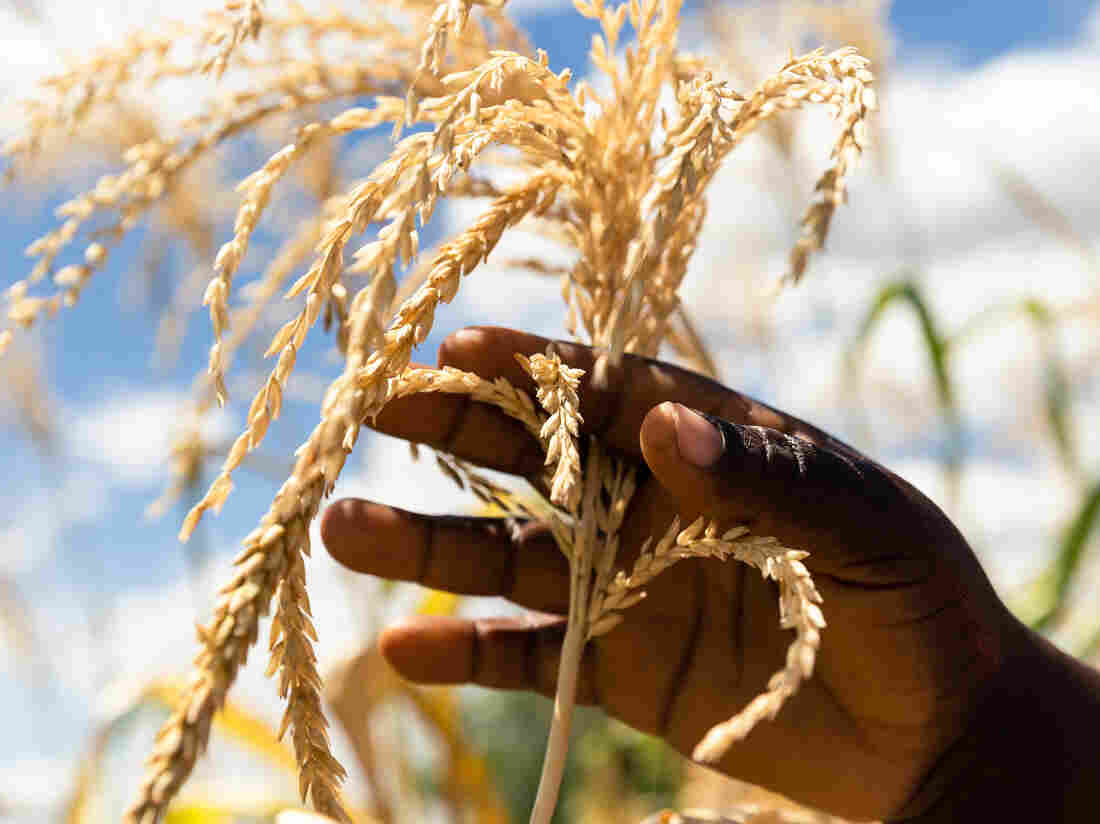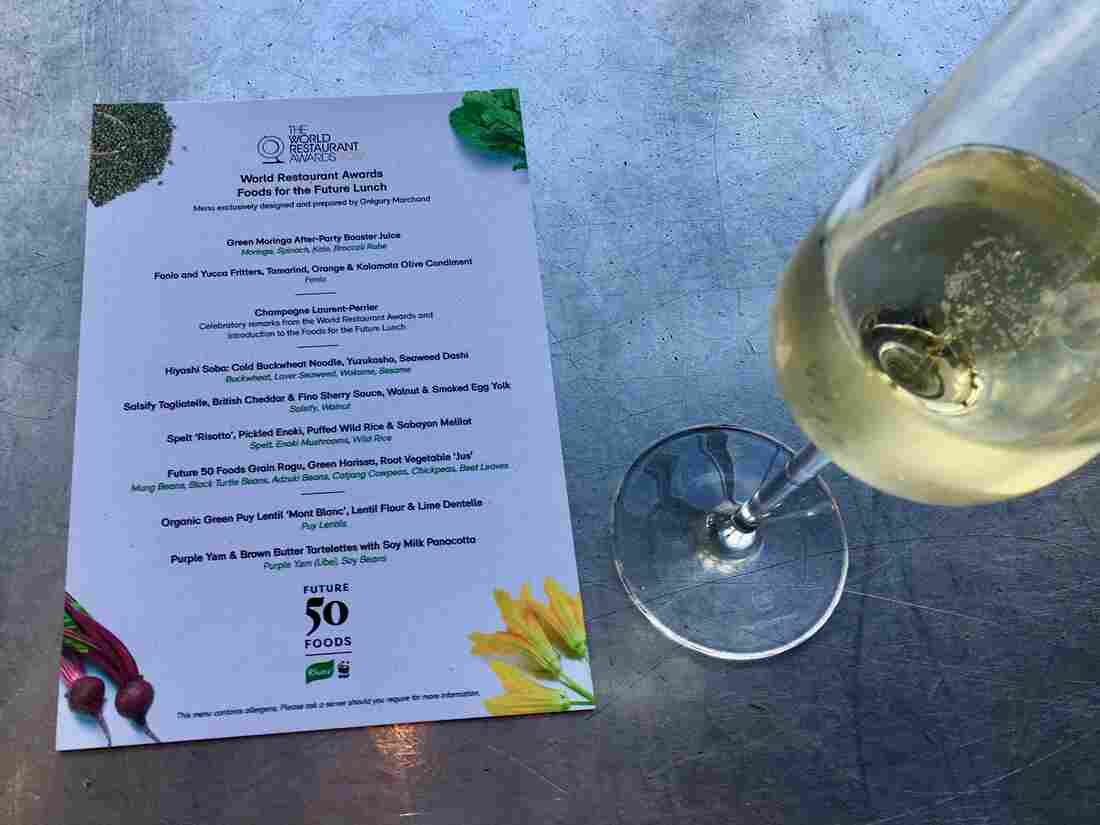
Just three crops — wheat, corn and rice — make up nearly 60 percent of the plant-based calories in most diets, according to a new report. Above, a farmer inspects a stunted cob in her dry maize field on March 13, 2019, in Zimbabwe. Jekesai Njikizana/AFP/Getty Images hide caption
Why would a wildlife conservation organization be involved in a campaign to push people to diversify their diets? As it turns out, the way we humans eat is very much linked to preserving wildlife — and many other issues. This was the topic at a recent conference in Paris where the World Wildlife Fund and Knorr foods teamed up to launch their campaign and report entitled "Future 50 Foods for healthier people and a healthy planet."
The WWF's David Edwards says there has been a 60 percent decline in wildlife populations since 1970, and working to protect animals is no longer enough to save them.
"We have to address the drivers of habitat loss and species collapse," says Edwards. "And the biggest driver is global farming."
According to the report, 75 percent of the food we consume comes from just 12 plant sources and five animal sources. And just three crops — wheat, corn and rice — make up nearly 60 percent of the plant-based calories in most diets.
The lack of variety in agriculture is both bad for nature and a threat to food security, the report says. It argues that it's essential we change our eating habits to protect the planet and ensure we are able to feed the growing global population.
The report says repeatedly harvesting the same crop on the same land depletes nutrients in the soil, leading to intensive use of fertilizers and pesticides that, when misused, can hurt wildlife and damage the environment. It pushes protein-rich plants-based foods that can be eaten in addition to or instead of meat. Red meat production in particular requires much more water and land than plants and produces significant greenhouse gas emissions, and it's a driver of deforestation.
The staggering wildlife loss in the last 50 years includes the precipitous decline in insect populations – often referred to as the insect Armageddon. "Nature can't continue to take this pressure," says Edwards. "The food system has pushed wildlife to the extremes."
Maria Haga, the head of Crop Trust, an organization focused on preserving crop diversity, says the new campaign is on target. "We probably have globally like 30,000 plants that we could eat," she says. "We eat roughly 150 of those." And to have just a handful of crops be so dominant is "really a challenge for the whole food system."
Haga says dependence on just a few crops is also a threat to food security. The world's population is on track to reach 10 billion by 2050. If we're to feed everyone with a changing climate, says Haga, we'll need diverse crops that can adapt to extreme weather conditions. The planet has lost thousands of varieties of foods in the last hundred years, says Haga. And once they're gone, they're gone forever.
Pierre Thiam from Senegal is now a chef in New York. He says people are beginning to wake up to the problem, and to the wide variety of alternative foods, many of which he grew up eating. One example is the ancient grain fonio, which resembles couscous.
"It's a grain that's great for the planet," says Thiam. "And it's gluten-free, it's drought-resistant, it grows in two months, it scores low on the glycemic index, so it's great for your health, too."
Thiam says many of the items on the "future foods" list are from Africa, which also has 60 percent of the world's arable land. But he says in recent decades, multinational food companies have been pushing Africans to import foods from the West, like bouillon cubes. Thiam says farmers are the backbone of the African economy and boosting their ability to make a living would lift up the entire continent.
The campaign's 50 foods were selected for their high nutritional value, low environmental impact, flavor, accessibility and affordability. Besides grains like fonio, they include various mushrooms, beans and pulses, nuts, tubers, algae and cacti.
Many of the food crops the report recommends have higher yields than the crops we currently rely on, and several are tolerant of challenging weather and environmental conditions, meaning they could not only reduce the land required for crops, but also prove invaluable in the face of growing climate uncertainty.
This being France, the report was served up with a four-course lunch featuring some of the 50 products.
Back in the kitchen, chef Francois Roche is busy shaving salsify, a root vegetable, into the form of tagliatella pasta. It will be served with British cheddar and fino sherry sauce, with walnuts and smoked egg yolk. He says the menu is very plant focused. He does not cook with much meat, mostly using it as a seasoning or part of a dish.

Chef Francois Roche's menu for a "Foods for the Future" luncheon included tagliatelle with British cheddar and sherry sauce, walnuts and smoked egg yolk. Eleanor Beardsley/NPR hide caption
Tshiqi Bongiwe is a magazine editor from South Africa. She's stunned by the wonderful tastes of all the plants. "This whole idea of diversifying our diets is very interesting from our perspective, because we come from a very staple, starch-and-meat type of environment in South Africa," she says. Wheat and maize are the biggies for us. So learning what we can replace them with is amazing."
You might expect global food conglomerates to resist such a diversity push. But Dorothy Shaver, who is head of sustainability for Knorr, says the company wants to be part of this move. She says the shift in the amount and types of food people eat is inevitable and will also open new markets.
"This actually gives us a major opportunity to identify some of the flavors that people are missing out on," she says. "And then we can get them on people's plates. We can get people to switch out one of their white potatoes that they eat potentially four or five times a week with a purple yam. Or in Indonesia make it an Indonesian sweet potato instead of white rice."
Shaver says doing this all over the planet would have an enormous impact on the environment. She says Knorr will try to mainstream 10 or 15 of these so-called future foods in its dishes. She says its popular cheddar and broccoli rice dish will soon have versions featuring black beans and quinoa instead of rice.
Sam Kass was White House chef under President Barack Obama and directed first lady Michelle Obama's "Let's Move" campaign. Kass says with one in three American kids now headed for obesity, a push to diversify our diets — with a greater focus on plant-based foods — is exactly what's needed.
"What's exciting about this is some of the biggest issues we face – climate change and human health – are coming together and the solutions are deeply aligned," he says. "What's good for us is also better for the planet."
Kass says consumers can just as easily drive the solutions as the problems. And don't worry if you're not familiar with foods like fonio or salsify root. You can start by cutting back on meat and eating more beans.
"Any bean," says Kass. "You can't go wrong. Black beans, pinto beans ... they couldn't be better for you and they are as sustainable as any other product."
Read Again https://www.npr.org/sections/thesalt/2019/03/24/706004242/for-a-healthier-planet-eat-these-50-foods-campaign-urgesBagikan Berita Ini















0 Response to "For A Healthier Planet, Eat These 50 Foods, Campaign Urges - NPR"
Post a Comment